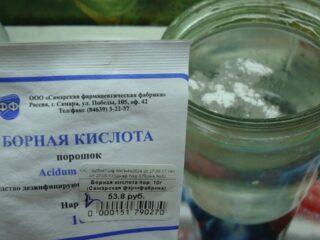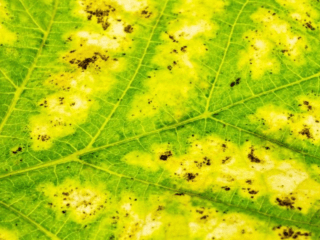Content
Oidium on grapes is a dangerous disease that can lead to massive infection of the entire garden. It appears as a white coating on leaves, young shoots and other above-ground parts of the plant. The most effective treatment method is treatment with fungicides. You can also use folk remedies. For prevention, it is recommended to follow the rules of agricultural technology, carry out spring treatments and choose varieties that are resistant to this disease.
What is oidium and why is it dangerous?
Powdery mildew is an infectious disease of grapes and many other crops. The causative agent is the microscopic fungus Oidium tuckeri, which is why the pathology is often called oidium. It is also called ashpelitsa or bel. This is a xerophytic fungus that parasitizes only living plants. It cannot be found on plucked, dry leaves, branches or bunches of grapes.
Oidium extracts nutrients and moisture from the plant tissues of grapes, which leads to their death. The pest does not pose a direct danger to humans, but powdery mildew causes enormous damage in agriculture. The disease develops and spreads very quickly. If you do not start treating grapes in the early stages, all plantings will probably suffer.
The consequences of powdery mildew are always negative:
- reduction in grape yield by 20-30%;
- loss of normal sugar content in fruits;
- decreased resistance to other pests and adverse weather conditions;
- death of shoots or death of the entire bush.
First symptoms
Before treating powdery mildew on grapes, you need to learn how to identify the disease. This can be done based on several signs:
- Dark spots of irregular shape appear on the shoots, and gradually they begin to merge with each other. Young shoots can especially suffer: they are completely covered with a white coating, as if with flour. If the disease is advanced, the shoots turn black and begin to die, the surface becomes unevenly lignified. These branches are more likely to suffer from frosts - in the spring they noticeably lag behind in growth and produce unusual, curly leaves.
- The inflorescences are affected by powdery mildew after the leaves and shoots - a white coating also appears on them. As a result, the flowers cannot grow and gradually fall off.
- After this, powdery mildew appears on grape fruits. Symptoms depend on the degree of maturity. Young fruits with low sugar content (up to 8%) are most susceptible to infection. A white coating appears on them, after which the berries dry out.If the infection was later, the grape fruits continue to grow, but they become deformed and crack. These berries have seeds that protrude outward. There are other external signs - the appearance of dark spots under the skin, its suberization, discoloration, and the appearance of a mesh pattern on the surface.

Leaves and fruits of grapes infected with oidium can be detected visually
At this time, no signs of the disease are noticeable, but the spores are already beginning to multiply and parasitize. When the described symptoms first appear, you must immediately begin treatment.
Difference from other diseases
A characteristic sign of oidium in grapes and other crops is the appearance of a white coating on the above-ground parts of the bushes. However, other symptoms may resemble other diseases. For example, powdery mildew is similar to black spot. In this case, oidium affects the upper leaves, and spotting, on the contrary, begins to develop from the lower ones.
There is also an external resemblance to downy mildew. But the latter develops not outside, but inside plant tissues. It leads to deformation of shoots and the appearance of rot, which is not typical for oidium.
Take the affected part of the plant and rub it between both hands. If the characteristic smell of rotten fish appears, it is definitely oidium.
Causes
Powdery mildew is common in all regions of temperate climates, it appears on both grapes and other plants. Even if correct agricultural practices are followed, its occurrence cannot be completely eliminated.It is worth remembering that several reasons can provoke the development of a pest:
- dry summer with stable daytime temperatures above +25 °C;
- prolonged heat (from +30) - in this case, powdery mildew will develop even without rain;
- warm, mild winters (at -30°C spores die);
- too high planting density;
- absence or irregular pruning of grapes - excessively thickened crown;
- regular violation of watering norms, excess moisture.

Hot weather promotes infection development
How to deal with powdery mildew (oidium) on grapes
Several effective measures have been developed to combat oidium on grapes. Gardeners strive to treat bushes with homemade solutions based on folk recipes - infusions, decoctions. This method helps only in the early stages of the development of the disease, as well as as a preventive measure. If the damage is quite severe and the disease spreads quickly, it is best to use special chemicals.
Folk remedies for oidium on grapes
Folk remedies are safe due to their natural composition. Therefore, they can be used even during fruiting, including several days before harvest. Below are the basic recipes that are used to treat grapes from powdery mildew:
- Horsetail - the grass is crushed together with the flowers, 1 kg of raw material is taken per 10 liters of water at room temperature and infused for three days. Then boil over moderate heat for two hours. Cool, filter, dilute with water five times, and begin processing. The finished infusion can be stored for up to seven days.
- You can treat grapes from powdery mildew with a solution of dry mustard powder, which is sold at any pharmacy.To do this, take warm water (10 l) and dissolve 2 tbsp. spoons, mix, let stand until room temperature is reached. Then they start spraying.
- A weak solution of potassium permanganate. Only 5 g is enough for a standard bucket of water. This remedy acts quickly, but after a few days the disease may continue to develop.
- Baking soda – 3 tbsp. l. for 3 liters, you can also add 1 tbsp. l. laundry soap shavings.
- Ash infusion – 1 kg per 10 l. Leave for five days, then boil for 20 minutes and filter. Bring the volume back to 10 liters and add 2 tbsp. l. laundry soap shavings.
Preparations (fungicides) for oidium on grapes
You can also spray grapes against powdery mildew with special antifungal preparations - fungicides. The most effective means are:
- "Bordeaux mixture";
- "Topaz";
- "Fundazol";
- “Colloidal sulfur” (concentration 1%);
- "Horus";
- "Cabrotop";
- "Oxychom";
- "Abiga Peak".

"Topaz" is one of the best fungicides for treating plants from oidium
Agrotechnical control measures
To prevent the appearance of powdery mildew on grapes, you can use proven agrotechnical methods:
- When planting, be sure to maintain an interval between seedlings of at least 2.5-3 m (depending on the growth vigor of the variety and the spreading nature of the crown).
- Apply nitrogen fertilizers only before the formation of bouquets begins. After this, potassium and phosphorus compounds are used.
- In the fall, prune and remove all branches and leaves, take them away and burn them. Do not use plant debris as mulch.
Preventive treatment of grapes against oidium
Even if the grapes have not previously suffered from powdery mildew, care must be taken to ensure that the bushes remain healthy.Experienced gardeners recommend following the following preventive measures:
- In early spring, treat with fungicides or folk remedies described above. For example, in the first days after opening the vines, you can spray them with Nitrafen (a universal remedy - fungicide and insecticide).
- Maintain watering rates while monitoring the weather forecast.
- In the summer, periodically inspect the grape bushes and, if the first signs of powdery mildew are detected, immediately carry out treatment.
- Provide timely feeding, especially at the budding stage. If the soil is depleted of nutrients, grapes may suffer from powdery mildew and other infections, as well as pests.
What to do if the disease is advanced
If a significant part of the grapes is affected by powdery mildew, you need to act immediately:
- cut off all diseased shoots to a healthy place;
- take the affected leaves and branches as far as possible and burn them;
- carry out a total treatment of the bush - you only need to use fungicides, since folk remedies may not be effective;
- at the same time, spray healthy grape plantings to prevent the spread of powdery mildew (it may also turn out that they are already affected by the fungus).
In severely damaged grapes, a significant part of the leaves and shoots is covered with a powdery coating. It is almost impossible to help such a bush - it is better to plant it and burn it to prevent infection of neighboring plantings.
Grape varieties resistant to blight
When choosing grape varieties for cultivation, preference should be given to those varieties that are immune to this pathology. Gardeners recommend the following varieties:
- Kishmish Zaporozhye;
- Dviet blue;
- Zaporozhye giant;
- Anthony the Great;
- Rochefort.
Conclusion
Oidium on grapes develops quite quickly - from the appearance of the first signs to the advanced stage it can take only a few weeks. Therefore, the disease requires immediate treatment. It must be remembered that fungicides cope best with oidium. Folk remedies can be used as an additional measure.













